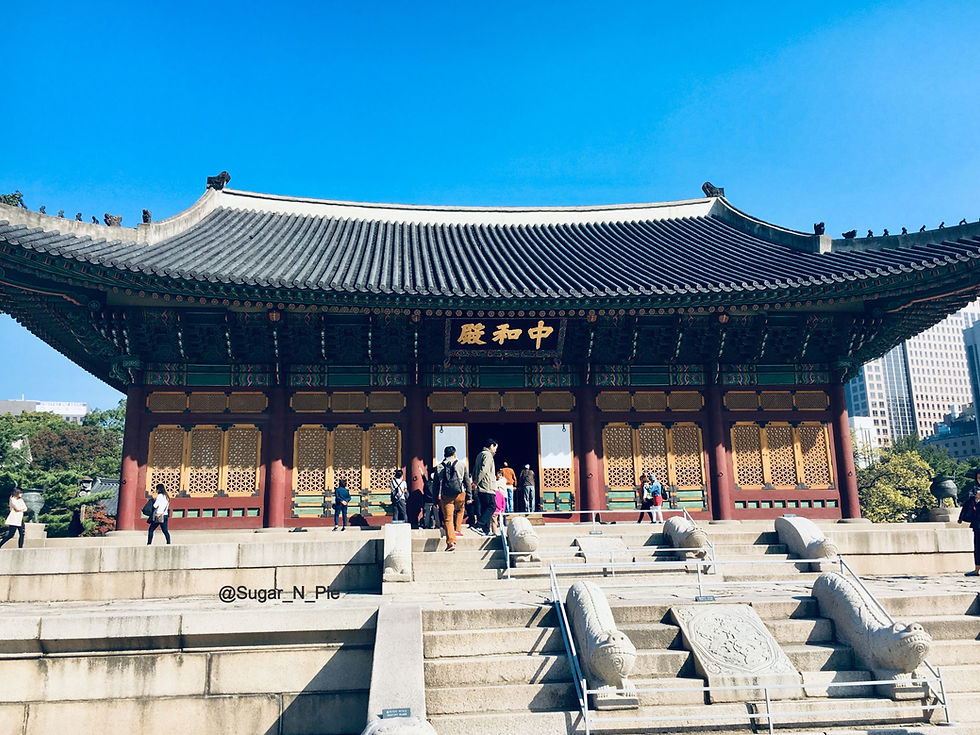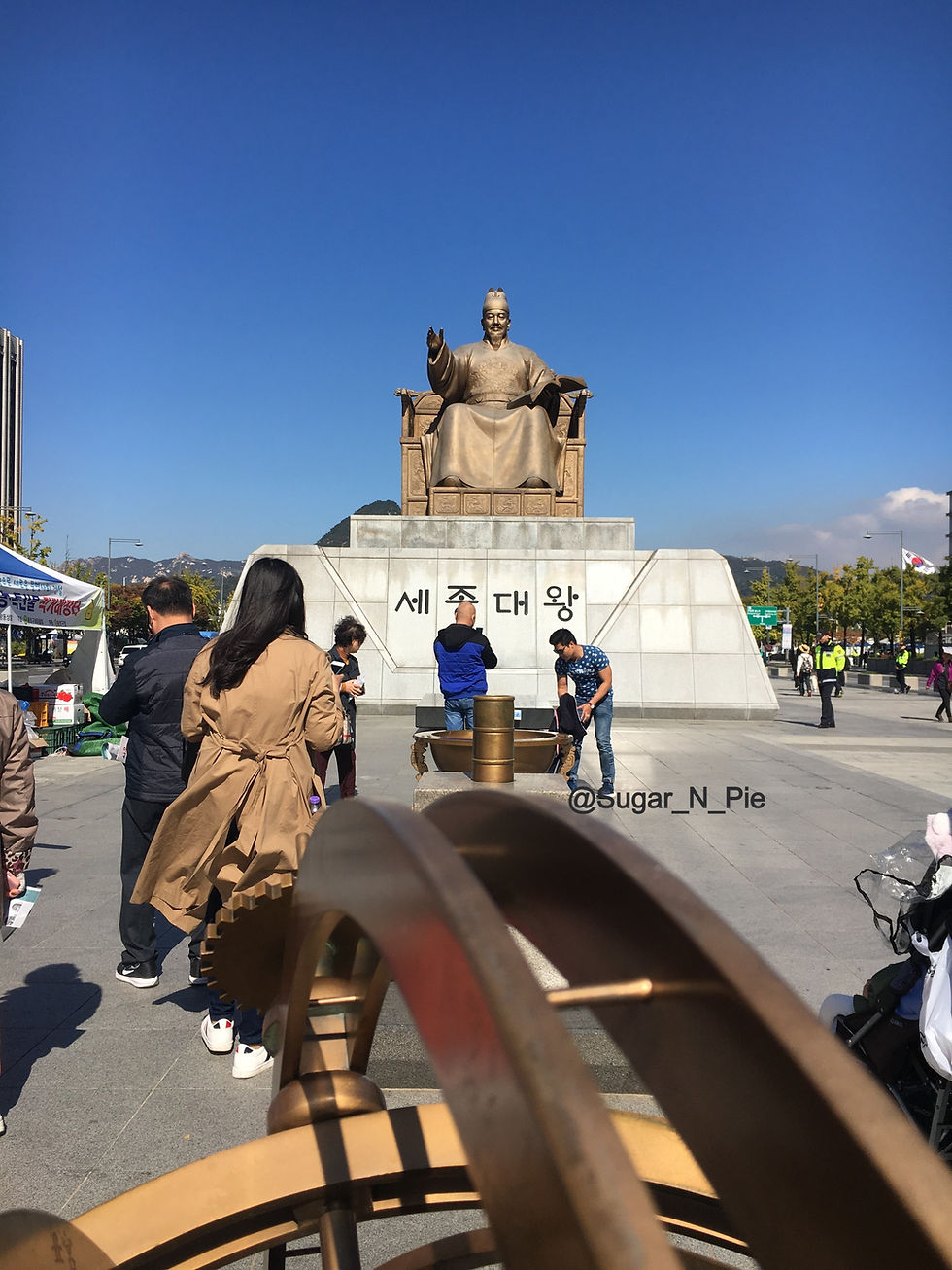13D12N Korea Itinerary|| D6 Seoul: Doeksugung-Gwanghamun Square-Gyeongbukgung Palace
- piepieworlds
- Oct 17, 2018
- 5 min read
Updated: Sep 9, 2023
Hi, welcome to Sugar N Pie Korea travel blog. In this blog, we gonna share our most wonderful 13-days journey in South Korea, travelling from the south to north. This day was our first day in Seoul. Hope this Seoul itinerary could help you to finetune your trip.
Seoul Itinerary
Day 1 : Grand Palaces
Doeksugung - Gwanghamun Square - Gyeongbukgung Palace
On our first day in Seoul, we visited the grand palaces of Korea. Before that, we went to Namdaemum Market which just located 5 minutes away from our guesthouse for breakfast first. The market is known as the oldest and largest market in South Korea with over 10,000 stores lining around the Namdaemum Gate. Too bad that most of the stores were still closed when we visit. Not sure why or was it still too early in the morning. Luckily we had taken some cereal before coming out. So we just moved on to the next destination.

First stop: Doeksugung Palace
We took bus no. 402 from Namdaemun Market to our next destination, Deoksugung Palace. The palace played an important role in Korea history. It was the final residence of King Gojong who was the last king of Joseon Dynasty and the first Emperor of Korea.

The entrance fee was 1000won for each of us. Other than usual one-day ticket, the ticket counter also sells Total Admission Pass, which visitor to visit the 5 grand historical palaces in Korea, with a fairer price and longer period.

Dated back to 15th century, Deoksugung wasn’t a palace originally. It was then being chosen as the temporarily palace for King Seonjo after all the palaces were being severely damaged during Imjin War. Prince Gwanghaegun who succeeded King Seonjo at this place, renamed it as “Hyeongungung Palace”, formalizing it as a royal palace. In late 19th century, Emperor Gojong expanded it with the western style of building and he continued to live in this palace even after being forced to pass the throne to his son. This palace was then renamed as “Deoksugung”, a palace of virtuous longevity.


Lucky enough, we had the chance to see how the royal guards changing shift in old days. The royal guards were taking the performance serious.
Overall, the palace might not be the grandest or most gorgeous, but the environment was quaint. The palace has its own unique peaceful charm. It was a pleasure experience to stroll around the palace, know more about Korean history while taking some good photo.
Do checkout the road beside of Deoksugung Palace, Deoksugung Doldam-gil~ It is known as one of the top 100 most beautiful road in Korea. Both of us see eye to eye with the statement. There is a great chemistry between the ancient stone wall of Deoksugung with the tall autumn tree lining along the road, which make the road picturesque and feeling relax when walk on it.

Second stop: Gwanghwamun Square
We boarded town bus no. Jongno09 at bus stop in front of City Hall Station and moved to next grand place, Gyeongbukgung Palace. We could saw the statue of King Sejong and Admiral Yi Sunshin right after geting off at KT Gwanghwamun. The great statues stand at the center of Gwanghwamun Square, which located at the front of Gyeongbukgung Palace. Gwanghwamun Square is the national landmark of Korea. Total 555m in long and 34 wide. The far stretched plaza connects Gyeongbokgung Palace to Cheonggye Stream. It displays the most symbolic icon in Korea history, including King Sejong and Admiral Yi Sunshin.

King Sejong the Great (1397-1450) is the forth king of Joseon Dynasty and creator of Hanguel (alphabet of Korea). Main inventions from his reign eg. rain gauge and celestial globe, are also displayed in front of him.

Admiral Yi Sunshin(1545-1598) is a naval commander noted for his victories against the Japanese navy during Imjin War in 1592-1598. The 12.23 fountain in front him commemorates the admiral’s 23 battles and 12 warships in the war.
Lunch & Rent Hanbok : Chebu-dong
Before being guest of the grand palace, both of us went to Chebu-dong, neighbourhood beside of Gyeongbukgung to fill up our stomach and rent hanbok, the traditional Korean attire. As usual, we surveyed around and entered the shop with most local customers. The statistic never disappoint us. We had a great lunch.
잘 먹겠습니다 (jal meo-kket-ssum-ni-da) φ(* ̄0 ̄)

Definitely is a MUST to wear Hanbok, the Korean traditional attire while visiting Korean palace. There are plenty of shops which provide hanbok renting services in Chebu-dong. We were being informed that it was fully booked at the first hanbok rental shop we went. Luckily the second shop had some empty slot for the normal traditional hanbok package and required to wait around 20mins for our turn. Hence, we do RECOMMEND people to pre-book online at least one day earlier especially during weekend, for more package options and better pricing. The service provided was pretty good. The staff would taught clueless foreign visitor like us the way to wear hanbok, helped us to braid our hair and put on those accessories. After all done, its time to back to Joseon Dynasty.
Third stop: Gyeongbokgung Palace

Gyeongbokgung Palace is the largest palace among the Five Grand Palaces, and also known as one of the most iconic sights in Korea. The statement was verified by ourselves. We had been impressed by the strong majestic aura of its main gate, Gwanghwamun Gate before entering the palace. Many visitors were also wearing hanbok like us.

The ticket counter sells regular one-day ticket and Total Admission Pass. And thanks to our hanbok, both of us were free of entrance fee when entering Gyeongbokgung Palace. ヾ(≧▽≦*)o
Gyeongbokgung Palace was first built at the heart of Hanyang (Seoul in nowadays) as the main palace when moving capital from Kaesong at the early days of Joseon Dynasty. But it was being destroyed by fire during Imjin War and left in ruins for about 270 years. The palace was restored as head of government and over 500 buildings were rebuilt with the help from Heungseon Daewongun in 1867. But again, the restored Gyeongbokgung was significantly damaged and over 90% of the buildings were demolished during the Japanese occupation. Current building was the one rebuilt in 1990 after the war long over.
Korean drama fans like us, wouldn't unfamiliar with Gyeongbokgung. Some of the main building, including Gwanghwamun, Geunjeongjeon Hall, the king throne in Geunjeongjeon Hall and Gyeonghoeru Pavilion, were as similar as seen in the Korean historical drama. We could picture how lively it was back to Joseon Dynasty when various royal events such as the coronation ceremony of king, cabinet meeting, receptions of foreign envoys and final state examination were held at here.

As Gyeongbokgung is the iconic heritage site in Korea, do expect that most of the hot spots would quite crowded. However, the palace is inordinate, and its beauty is inside and out. You surely can find some quiet, picturesque corner in the palace and take some mesmerizing photo. Definitely worth to pay a visit to this marvel of Korean history and immerse in its beauty.
Dinner : Myeongdong

After returned hanbok to the rental shop, we were going to Myeondong Street for dinner. We took Line 3 subway from Gyeongbokgung station back to Myeondong station. There were tons of foods selling here, eg. Korean food, western food, chinese food, Indian food etc. We had Naengmyeon (Korean cold noodles) and Jjamppong (Korean Spicy Seafood noodles) as dinner.
맛있다~~~ (❁´◡`❁)
*(mas-issda, taste good in korean)
Definitely that wouldn't be our last stop. Dessert is a must! We pampered ourselves with some delicious matcha drink and cakes from Osulloc Tea House. To be honest, I'm not a huge matcha fans. Their matcha series were superb! The matcha was well blended inside the dessert. It was so smooth and we will never overwhelm by its strong matcha. ❤️

It was almost 9.30pm when we back to room.
This is all our activities on Day-6 in Korea.
See you next day, byeヾ(≧▽≦*)o













Comments